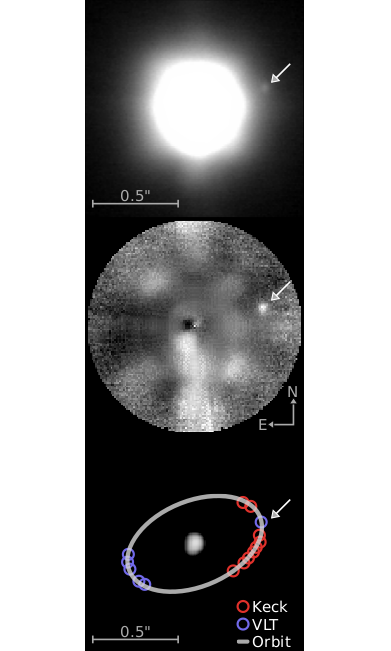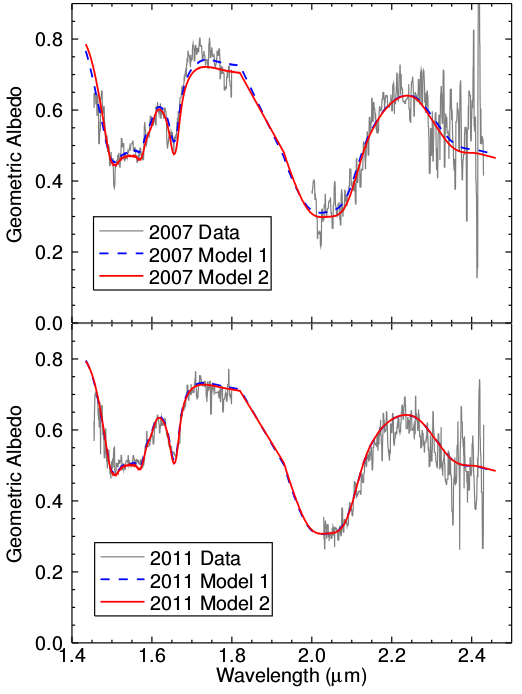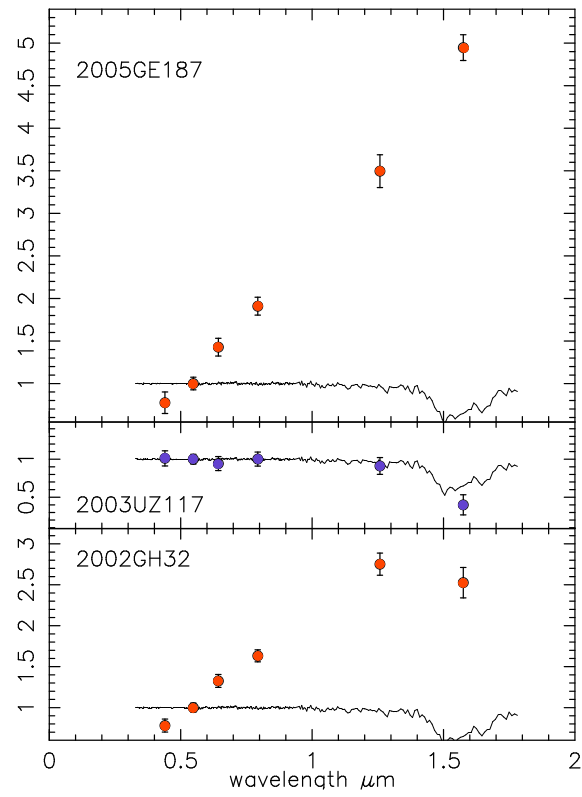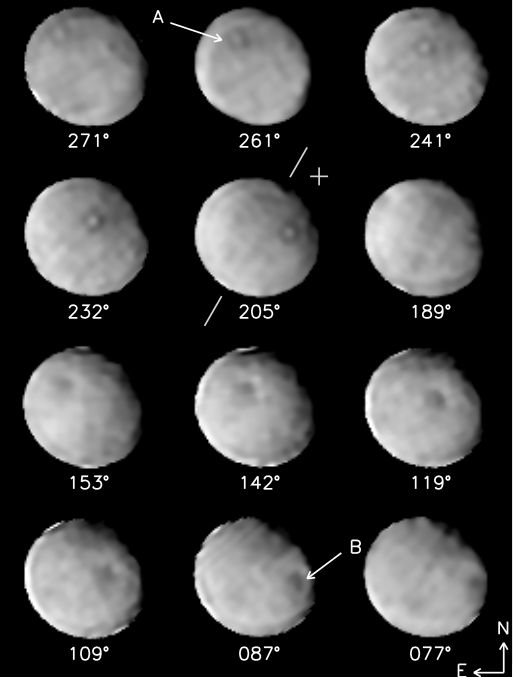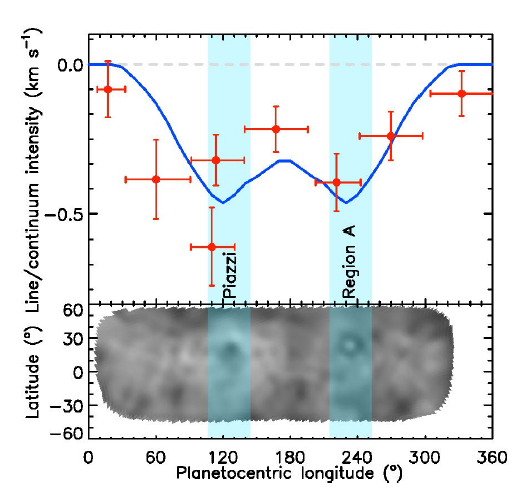On-going research activities
On-going research activities
Astronomy is now entering in the era of big data. Research articles on asteroids in the 70s and 80s usually focused on a single object, for instance describing its rotation lightcurve. With the advent of CCD cameras, and computing power, large surveys have become the rule in astronomy. We now deal with some 105 minor planets, and statistical studies of their orbits, compositions, and physical properties is finally within reach.
Solar System evolution from compositional mapping of the asteroid belt
The Sloan Digital Sky Survey (SDSS) is an imaging and spectroscopy survey dedicated to observing galaxies and quasars (Ivezic et al. 2001). The images were taken in five filters, from 0.3 to 1.0 micron, between 1998 and 2009. The survey also observed about 100,000 moving objects in our Solar System. With Francesca DeMeo, we used these colors to classify the asteroids in a scheme compatible with the taxonomy currently in use (DeMeo et al. 2009). Carefully estimating the different biases on the sample, we used it to study the distribution of taxonomic classes among main belt asteroids and Jupiter trojans (DeMeo & Carry 2013). This corresponded to a major update of the classical view of the main belt, from the early 80s (Gradie & Tedesco 1982). We also unveiled different structures with diameters for different taxonomic classes (DeMeo & Carry 2014).
Spectral properties of near-Earth and Mars-crossing asteroids
If the SDSS consortium had published an extensive catalog of asteroids in the main belt, only a few NEAs were listed. With Enrique Solano, we set up a citizen-science project using VO tools and protocols to find the NEAs in SDSS images (Solano et al. 2014). We classified 206 near-Earth and 776 Mars-crosser asteroids with the photometry measured by our citizen-science project on SDSS images, representing an increase of 40% and 663% of known taxonomy classifications in these populations. Using this sample, we studied the source regions of NEA and the effect of planetary encounters on asteroid surfaces (Carry et al. 2016).

Asteroid observations by ESA Gaia
The ESA astrometry Gaia mission is a survey that repeatedly measures the position of celestial bodies at the micro-arcsecond level over five years. Every source brighter than V=20.7 is detected by Gaia, and its position, broad-band "visible" photometry, and low-resolution (R~35) spectrum are downloaded to Earth. Over the course of its survey, Gaia will image about 300,000 minor planets, 50 to 60 times each (see Mignard et al. 2007 for a description of Gaia and its application to Solar System science).
A specific pipeline, dedicated to minor planets (Tanga et al. 2016), has been set up within the Gaia Data Processing and Analysis Consortium (DPAC) that I joined in 2012. I am involved in the daily processing, which aims at releasing call for observations ("alerts") upon the discovery of new asteroids by Gaia. For that, a short-term orbital inversion is ran on Gaia astrometry (Muinonen et al. 2016). Given the observing geometry of Gaia near quadrature, a couple of NEA discovery per week are expected (Carry et al. 2014), once the chain will be operationnal. To prepare the network of support observers, we already organized three workshops in Paris (in 2010, 2012, and 2014) and a training campaign on (99942) Apophis (Thuillot et al. 2015).
Solar System Science with ESA Euclid
The ESA Euclid mission will conduct a visible and near-infrared imaging and spectroscopic survey over 15,000 deg2, down to a magnitude of VAB∼24.5. Although the survey design will avoid ecliptic latitudes below 15°, the imaging sequence in repeated sequences of four broad-band filters is casually very much adapted to Solar System Objects (SSO) detection and characterization. With current survey design, several 105 SSOs should be observed by Euclid (Carry, 2018). These objects will all have high inclination, which contrasts with many surveys focusing on the ecliptic plane.
The hour long sequence of observation will allow to determine preliminary orbits, and follow-up of some specific targets can be envisioned. These observations, consisting in a suite of four sequences of four measurements, can be used to determine the rotation period, spin orientation, and 3-D shape model, once combined with sparse photometry such as measured by ESA Gaia and LSST. The prospect for spectral characterization seems the most promising: by extending the spectral coverage provided by ESA Gaia and LSST into the near-infrared, Euclid will refine the spectral classification of SSOs (Carry, 2018).
Following my early interest on asteroid 3-D shape modeling (e.g., Carry et al. 2008, 2010a, 2010b, 2012, Durech et al. 2015, see below), multiplicity (e.g, Carry et al. 2011, 2015, Margot et al. 2015, see below), and density (Carry 2012, Scheeres et al. 2015, see below), I now focus on multiple systems, and contribute to shape modeling studies.
3-D shape modeling with amateurs and development of the algorithm
In 2012, we started with Marco Delbo and Josef Durech to implement a thermophysical module in KOALA, allowing the use of photometry in the thermal infrared to be used to constrain the spin and 3-D shape of asteroids. We added this implementation into the well-established convex shape inversion (Kaasalainen et al. 2001), to conduct tests on the algorithm on a more controled environement first (Durech et al. 2012). We recently submitted the study of (162173) Ryugu, the target of the JAXA mission Hayabusa-2 (Müller et al.), using our novel technique.
The 3-D shape modeling requires many different geometries to be observed. This is why I am interested in data mining archives with time-serie photometry, such as the NASA K2 spacecraft (Berthier et al. 2016). I also maintain a close collaboration with amateur astronomers, mainly from the CdR groupe, with who we already published several articles (e.g., Carry et al. 2010, Hanus et al. 2013, 2016) and gathered in different Pro-Am workshops (see Mousis et al. 2014 for a description of on-going collaborations between professional and amateur astronomers in planetary sciences).
Characterization of binary asteroid systems
After my recruitment at the IMCCE in 2012, I invested a lot into improving my data reduction pipeline for AO images. The aim was to subtract the halo surrounding asteroids to better detect their faint satellites. In parallel, my collaborators Frédéric Vachier and Jérôme Berthier worked hard on Genoid (Vachier et al. 2012), to improve how it converges to the orbital solutions. The goal with all this preparatory work is to reprocess images of binary asteroids from large ground-based telescope archives, determine minute ephemerides, and organize stellar occultation observing campaigns. It is indeed the only observing technique which can resolve the small satellites of large main-belt asteroids, and provide a first glimpse on these worlds.
A stellar occultation by (87) Sylvia in early 2013 provided a spectacular demonstration of the reliability of our approach. Before the occultation, we had compiled 10 years of AO images of Sylvia, and predicted the occultation path of its two satellites, using Genoid. The occultation by Romulus was recorded at less than 14 km away from its predicted position, which is extremely precise considering the semi-major axis of its orbit of 1350 km (Berthier et al. 2014). Since then, we have produced orbital solutions for almost a dozen systems, and we propose predictions for upcoming stellar occultations.
We recently published updated orbits for the two satellites of (136108) Haumea (Gourgeot et al. 2016) and my Ph.D. student Myriam Pajuelo is now writing an article on (107) Camilla, for which we drastically improved the known orbit (Marchis et al. 2008). We compiled more than twice as much observations, covering almost 15 years, and yet achieved a value of only 9 mas for the mean residuals between the predicted and observed positions of the satellites, compared to 22 mas for the previous orbit (Pajuelo et al. 2015). This implies that the dynamical parameters of the system are much better constrained, and our capability to predict the occultation path of the satellites is vastly enhanced.
Previous research
Studying the basic geometric properties of asteroids is crucial in many aspect. For instance, the diameter-period distribution hinted at the formation of pairs and binaries by YORP spin-up and fission (Pravec et al. 2010), the spin-axis distribution of small asteroids is reminiscent of YORP (Hanus et al. 2013), shape modeling is required for accurate density estimates (Carry 2012), and so forth.
KOALA: Knitted Occultations, Adaptive-optics & Lightcurves Analysis
I started my Ph.D. by studying (1) Ceres (see below) from disk-revolved images obtained with AO. The strength of disk-resolved imaging was obvious, as it provided direct information on the size and shape. Yet, while I started to study (2) Pallas, its irregular shape required a more extensive approach. This is how the multi-data shape inversion technique, that we called Knitted Occultations, Adaptive-optics & Lightcurves Analysis (KOALA) came to light (Carry et al. 2010, Kaasalainen 2011), under the magic fingers of Mikko Kaasalainen.
Soon after the successful application of KOALA to (2) Pallas, we determined the rotation period, spin-vector orientation, and 3-D shape of (21) Lutetia, in support to the forthcoming flyby of the asteroid by the ESA mission Rosetta (Drummond et al. 2010, Carry et al. 2010). The images taken by the OSIRIS camera during the flyby (Sierks et al. 2011) spectacularly demonstrated the validity of our approach: The spin axis we determined with KOALA was found to be accurate to within two degrees, while the shape was accurate to only 2 km RMS for a diameter of 98 km (Carry et al. 2012).
While the development of the algorithm was pushed further by Matti Viikinkoski, we applied it to study the binary asteroid (87) Sylvia (Berthier et al. 2014), the thought-to-be binary (234) Barbara, showing that its peculiar lightcurve and interferometric visibilities could be explained by a highly irregular shape (Tanga et al. 2015), the C-type (52) Europa (Merline et al. 2013), and to the very first data taken with both ALMA interferometric sub-mm array and ESO SPHERE extreme AO camera on asteroids during their science verification phase, modeling the asteroid (3) Juno (Viikinkoski et al. 2015). Based on our experience, we wrote the chapter dedicated to asteroid shape modeling in the recent decadal review book Asteroids IV (Durech et al. 2015).
Binary, or more generally multiple, systems have always been prime targets in astrophysics: by studying the system dynamics, it is possible to determine its total mass, or even the mass of each components. In the case of asteroids, this provides their density, perhaps the most fundamental parameters to understand their composition and internal structure. The orbital parameters of the systems and the physical parameters of their components hold the key to their origins, hence the need for discovery surveys and follow-up characterization. Spectral comparison of minor bodies with their satellites also tell us about their origins.
Discovery of satellites by adaptive-optics (AO) imaging
I have been involved in several programs of AO-imaging of large main-belt asteroids, searching for satellites. We used the W. M. Keck, Gemini, and ESO VLT telescopes. Our surveys led to the discovery of the satellites of (41) Daphne (Conrad et al. 2008), (317) Roxane (Merline et al. 2009), and (2577) Litva (Merline et al. 2013). We also took the first optical-image ever of a binary NEA: (35107) 1991 VH (Merline et al. 2008).
Characterization of binary systems
I have used large ground-based telescopes equipped with AO cameras to image binary asteroids and KBOs. Twice, we used the ESO laser facility (LGS) to take spectro-imaging observations of the KBO (136108) Haumea with SINFONI, studying the tide effects in the system (Dumas et al, 2011) and the spectra of Haumea (Gourgeot et al. 2016). Using a close encounter on the plane of the sky between a bright star (the NGS) and the KBO (90482) Orcus, we achieved the best signal-to-noise ratio observations of this object, revealing its surface composition and near-infrared colors of its satellite Vanth (Carry et al. 2011).
Compiling a decade of AO images of the asteroid (87) Sylvia, we determined minute orbital parameters for its two satellites, Romulus and Remus, using the Genoid algorithm (Vachier et al. 2012). This led to the successful prediction and observation of a stellar occultation by Romulus in 2013, showing the great potential of stellar occultations for the study of binary asteroids and confirming the results of Genoid (Berthier et al. 2014).
In an attempt to push further the angular resolution, I led the study of the small binary asteroid (939) Isberga, using the interferometric instrument MIDI at the ESO VLT (Carry et al. 2015). The technique showed great promises although current limiting magnitude of interferometric instruments prevails its applications to most binary asteroids. A summary of the last decade of characterization of binary asteroids can be found in the decadal review book Asteroids IV, in which I co-wrote the chapter dedicated to multiple asteroids (Margot et al. 2015).
Density is a fundamental property for the understanding of the composition and internal structure of minor bodies of our Solar System. Intrinsic physical properties of small bodies can be understood by searching for relationships between the dynamical and taxonomic classes, size, and density.
Density of asteroids
In May 2011, I was invited to give a talk on the "Shape models and densities of asteroids in the post-Gaia era" during the GREAT workshop on Solar System Science before and after Gaia, in Pisa (Italy). What was originally an attempt to slightly update a figure by Consolmagno et al. 2008 turned out to be a massive statistical analysis of over 1000 mass and 1500 diameter estimates of minor bodies! With density determined for about 300 objects, trends of density and porosity with size, taxonomic classes, dynamical classes could be studied. The compilation of all these estimates, comparison of their respective analysis methods, and statistical description of minor planet densities were published in Carry (2012) and updated in the chapter dedicated to asteroids interiors in the decadal review book Asteroids IV (Scheeres et al. 2015)
Although the original focus of my Ph.D. was the physical properties of asteroids, I quickly turned my attention to KBOs too: these icy bodies beyond Neptune are also the left-overs of planetary formation, and hold clues on our origins. Yet, the observation of KBOs is somehow harder than that of asteroids, as they are typically much much fainter. Achieving disk-resolved images, resolving components in multiple systems, or acquiring reflectance spectra require large telescopes, and often tricky uses of AO...
Near-infrared spectroscopy of KBOs
Knowing the advantage in angular resolution, hence flux concentration, provided by AO, we used the ESO LGS facility to acquire integral-field spectra of the multiple KBO (136108) Haumea (Dumas et al. 2011). We could refine the orbit of its main satellite, and characterize its surface composition. Repeating the exercice a few years later, we studied the variability of Haumea's surface composition over its rotation (Gourgeot et al. 2016).
We pushed further the idea, and using a close encounter on the plane of the sky between a bright star (this time relying on the higher AO performances achieved with a NGS) and the KBO (90482) Orcus, we achieved the best signal-to-noise ratio observations of this object, revealing its surface composition and near-infrared colors of its satellite Vanth (Carry et al. 2011).
Compiling a decade of observations of Charon, the main satellite of (134340) Pluto, and using the set of tools developed to study the methane absorption in the near-infrared spectrum of Orcus, we studied the variability of ammonia hydrate ice over Charon surface (DeMeo et al. 2015).
Charaterization of Haumea's family by photometry
Because KBOs are faint, achieving high signal-to-noise ratio spectroscopy is challenging. Conversely, broad-band filters are generally not well suited to detect the narrow absorption bands of ices. To study the dynamical family of (136108) Haumea, identified by Brown et al. 2007 and Ragozzine & Brown 2007, we used the Hawk-I instrument on ESO VLT taking advantage of its narrow-band CH4 filter, well-suited to detect the water ice absorption band.
We conducted a survey and characterized 30 out of the 35 candidate members (Snodgrass et al. 2010, Carry et al. 2012). First, we refined the limits of the family by comparing the orbital elements of the candidates and the confirmed members. Second, we evaluated the density of the family members by studying their rotation properties. As a by-product of our efforts to process the imaging data, we published a simple procedure to remove the fringe patterns in images taken at red wavelengths (Snodgrass & Carry 2013).
Asteroids (1) Ceres and (4) Vesta are the two largest asteroids in the asteroid main belt, the main reservoir of primitive material of the inner Solar System, between Mars and Jupiter. With diameters of about 1000 and 500 km, these two bodies are the leftovers of the planetessimals that accreted to form the terrestrial planets and the cores of the giant planets. With a launch date foreseen in the second half of 2007, and expected arrival dates at Vesta in 2011, and Ceres in 2015, I started to work on these two bodies from ground-based observations at the beginning of my Ph.D. thesis in November 2006, soon after the classification of Ceres as a dwarf-planet by the IAU. The aim was to characterize the surface of these two asteroids, and to determine Ceres spin orientation and shape in preparation for the NASA Dawn mission.
Physical properties and first near-infrared mapping of Ceres
I used disk-resolved images of Ceres, taken with the NIRC2 adaptive-optics (AO) fed camera at the W. M. Keck telescope in 2002 by my Ph.D. supervisor Christophe Dumas, to study the spin orientation, shape, size of Ceres, and to produce the first maps of its surface in the near-infrared. The challenge was the reconstruction of the angular resolution of the images, their degradation by the atmospheric turbulence being only partially corrected by the AO system. I used for that the Mistral deconvolution algorithm (Mugnier et al. 2004).
The result of this study lead to my first publication as first author (Carry et al., 2008). The maps I derived revealed a wealth of surface features, with albedo variation of a few percent. These features were also visible in maps in the visible from HST images (Li et al. 2006). The spin-vector coordinates and tri-axial dimensions I found were, however, not in agreement with those published by Thomas et al. (2005) from HST imaging. In a comprehensive analysis of all available AO images of Ceres taken from ESO VLT and W. M. Keck, we later confirmed the orientation and dimensions I had first determined (Drummond et al. 2014). The images taken by the Dawn mission in orbit around Ceres have at last confirmed our values (Russel et al. 2016), illustrating the capabilities of large ground-based adaptive-optics-equipped telescopes and the validity of our analysis.
First disk-resolved spectroscopy of (1) Ceres and (4) Vesta
At the vanguard of high-angular resolution techniques, we used the integral-field spectrograph SINFONI during its Science Verification phase, and obtained the first disk-resolved spectra of the surface of (4) Vesta. The spatial coverage of these observations was limited, and so the angular resolution due to moderate atmospheric conditions at the time of the observations. We nevertheless confirmed a surface composition compatible with Howardite meteorites, and a potential inverse correlation between albedo and spectral slope (Carry et al. 2010).
We also mapped Ceres surface with SINFONI, from 1 to 2 micron, with a spectacular spatial resolution of about 75 km (Carry et al. 2012). The level of homogeneity of the surface in the near-infrared was surprising, but the slight variations of spectral slope we detected (about 2%) correlated well with albedo markings (Li et al. 2006, Carry et al. 2008).
Detection of water vapor at (1) Ceres
In the late 1970s, from observation of (1) Ceres in the 3 micron wavelength range, Lebofksy (1978) suggested the presence of water ice on the surface or sub-surface of Ceres. Many authors studied this absorption band since then, attempting to decode Ceres composition. When A'Hearn & Feldman (1992) reported the detection of OH vapor at Ceres pole (although marginal), the question of the presence of water ice in the asteroid belt got more attention.
Using the UVES high-resolution spectrograph of the ESO VLT, I participated to the search of OH around Ceres, in an attempt to confirm previous detection (Rousselot et al. 2011). We finally succeeded once we used the ESA spaceborn telescope Herschel to directly detect H2O. We even determined the localization of the emission by studying the variation of H2O over Ceres rotation (Küppers et al. 2014).





